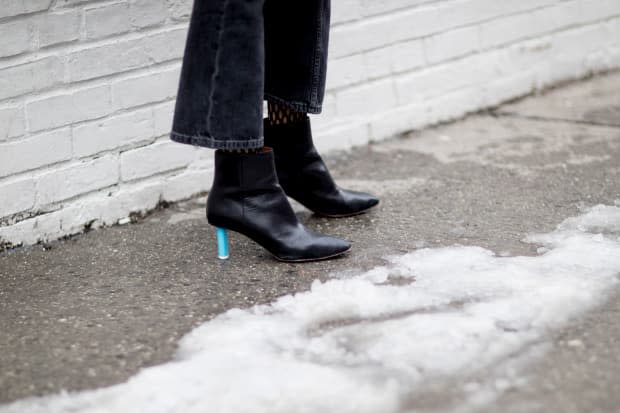Back to Basics: How to Prep Your Suede and Leather Boots for the Winter
Your January self will thank you.

"Basic" may have adapted a negative connotation in recent years, but there's no shame in seeking advice on theoretically simple sartorial conundrums. In our latest column, "Back to Basics," we're here to guide you through life's most common (and important) fashion and beauty concerns.
Slipping your feet into a new pair of suede or leather boots is the sartorial start to winter. At first the shoes may feel a little stiff and unfamiliar, but by the end of the season, they'll seem as if they were custom-made for your feet. You'll wear them to work, to dinner and for weekend play. You'll learn how to dress them up or down and which fuzzy socks work best with them. They'll become the backbone of your cold-weather wardrobe, subtly supporting your statement coats and punchy knits.
But the downside of some of the most stylish boots — particularly ones made of suede and leather — are their (in)ability to handle winter's harsh elements. Leather is an animal skin, which is susceptible to drying out and cracking if it's not treated with care. If you plan to brave January's unpredictable pavements in leather booties or if your weather app tends to lead you astray, applying a protective spray and a conditioner to your shoes every few weeks could save you a costly trip to the cobbler. Read on for how to weatherproof leather and suede boots.
Keep your boots clean
Before applying any sort of treatment to your boots, make sure they are clean. This means checking them for dirt after each wear. With suede, you can knock off any dirt with a stiff brush before it penetrates into the skin and becomes permanent. With leather, you can take a very damp cloth and rub it on the newly formed stain and it should come right off.
Apply a protective spray every few weeks
It's popular and well-advised to apply a protective spray to leather shoes, especially if you plan on wearing them every day. Plenty of products can block water from getting in and prevent stains, without changing the look or the feel of the shoe. David Mesquita, vice president and co-owner of The Leather Spa, recommends using a repellant as opposed to fully waterproofing. "When the material is waterproofed, it changes the breathing capabilities of the leather or suede," says Mesquita over the phone. A repellant spray often incorporates nanotechnology, a coating process whereby tiny particles fill the minuscule openings in the leather to stop water from getting in.
"If it's a quality shoe that has leather lining, then it's fully breathable. The reason why we don't waterproof is because we don't want to seal the skin or the pores to change those capabilities. The repellent works to make an invisible shield over the item, with the idea that if you were ever to spill something or drop something on it, you would have enough time to remove it before it penetrates the skin."
In terms of application, you should apply a thin layer every few weeks. The spray will wear off as it's applied to the elements. "Think of it like if you put a moisturizer or conditioner on your skin: It doesn't last the whole season," Mesquita explains. "It's the same thing with the spray. If you have a pair of leather or suede shoes that you wear once or twice a week, you can spray them every two weeks."
It's also worth noting that there's no product you can use on patent leather, and for good reason: It's already waterproof.
If the shoe does get wet, stuff it with newspaper and apply moisturizer
When you do get stuck in the rain while wearing leather shoes, stuffing them with newspaper or paper towels can help keep their original shape and ensure that they don't shrink. The shoes should then air-dry naturally at room temperature. Once the leather footwear is dry, you can apply a leather conditioner, which will restore flexibility in the fibers and help prevent any cracks from harsh weather.
To go about conditioning your shoes, first remove any laces and make sure the boots are completely dry. Then, put a nickel-size amount of leather conditioner onto a cloth or sponge and apply all over the boots. Once your shoe skin is properly moisturized, leave the boots unworn overnight to allow the conditioner to soak into the leather.
Avoid wearing suede in the rain or snow
For suede, to restore its original texture, softly brush back up the nap. Unfortunately, there is no conditioner you can apply to suede. However, Mesquita suggests trying to avoid wearing suede shoes when there is any chance of precipitation. If you want to keep your suede shoes in pristine condition and it starts to drizzle "take you shoes off and put them in a bag and walk barefoot," he says.
Invest in weatherproof shoes
The best way to keep your leather and suede shoes in tip-top shape? Invest in a pair of shoes designed to be worn in rain or snow. There are a variety of all-weather-resistant boots that will safely and stylishly take you around when winter throws those treacherously slushy curveballs.
